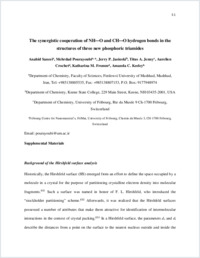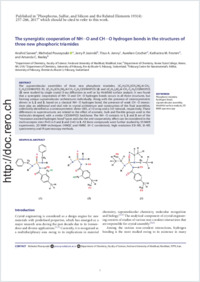The synergistic cooperation of NH⋯O and CH⋯O hydrogen bonds in the structures of three new phosphoric triamides
- Saneei, Anahid Department of Chemistry, Faculty of Science, Ferdowsi University of Mashhad, Mashhad, Iran
- Pourayoubi, Mehrdad Department of Chemistry, Faculty of Science, Ferdowsi University of Mashhad, Mashhad, Iran
- Jasinski, Jerry P. Department of Chemistry, Keene State College, Keene, NH, USA
- Jenny, Titus A. Department of Chemistry, University of Fribourg, Switzerland
- Crochet, Aurélien Fribourg Centre for Nanomaterial’s, FriMat, University of Fribourg, Switzerland
- Fromm, Katharina M. Fribourg Centre for Nanomaterial’s, FriMat, University of Fribourg, Switzerland
- Keeley, Amanda C. Department of Chemistry, Keene State College, Keene, NH, USA
-
27.11.2017
Published in:
- Phosphorus, Sulfur, and Silicon and the Related Elements. - 2018, vol. 193, no. 4, p. 257-266
English
The supramolecular assemblies of three new phosphoric triamides, {(C6H5CH2)(CH3)N}2(4-CH3-C6H4C(O)NH)P(O) (1), {(C6H11)(CH3)N}2(4-CH3-C6H4C(O)NH)P(O) (2) and {(C2H5)2N}2(4-CH3-C6H4C(O)NH)P(O) (3) were studied by single crystal X-ray diffraction as well as by Hirshfeld surface analysis. It was found that a synergistic cooperation of NH⋯O and CH⋯O hydrogen bonds occurs in all three structures, but forming unique supramolecular architectures individually. Along with the presence of centrosymmetric dimers in 1, 2 and 3, based on a classical NH⋯O hydrogen bond, the presence of weak CH⋯O interactions play an additional and vital role in crystal architecture and construction of the final assemblies, collectively identified as a centrosymmetric dimer (0D), a 1-D array and a 3-D network, respectively. These differences in superstructures are related to the effect of aromatic, bulk and flexible groups used in the molecules designed, with a similar C(O)NHP(O) backbone. The NH⋯O contacts in 1, 2 and 3 are of the “resonance-assisted hydrogen bond” types and also the anti-cooperativity effect can be considered in the multi-acceptor sites P═O in 1 and 2 and C═O in 3. All three compounds were further studied by 1D NMR experiments, 2D NMR techniques (HMQC and HMBC (H–C correlation)), high resolution ESI–MS, EI–MS spectrometry and IR spectroscopy methods.
- Faculty
- Faculté des sciences et de médecine
- Department
- Département de Chimie
- Language
-
- English
- Classification
- Chemistry
- License
- License undefined
- Identifiers
-
- RERO DOC 309448
- DOI 10.1080/10426507.2017.1399128
- Persistent URL
- https://folia.unifr.ch/unifr/documents/306950
Other files
Statistics
Document views: 115
File downloads:
- fro_scn_sm.pdf: 151
- fro_scn.pdf: 139

